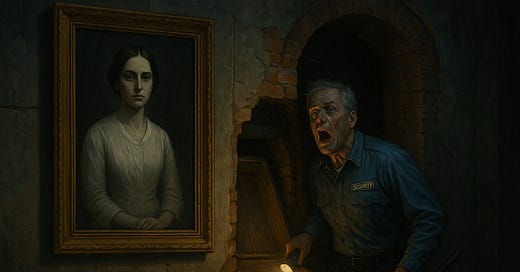Marcus pulled his security sedan into the gravel lot behind Vigil House, the tires crunching like bones. Three weeks left until retirement, and he was babysitting another renovation site. So much for a quiet send-off.
The building loomed against the overcast October sky—Gothic Revival towers and carved stone arches, now shackled with glass doors, motion sensors, and aluminum ramps. Corporate called it a “preservation-minded adaptive reuse,” but the house looked like a mausoleum with a spreadsheet taped to the door.
Marcus grumbled and grabbed his thermos and clipboard. He’d been doing night security for thirty-two years. No gun, no glory—just a flashlight and rounds every two hours. Empty buildings were the best: no people, no politics, no trouble.
Inside, the contrast was obscene. Drop ceilings and LED panels sliced through what had once been a grand Victorian interior. Plastic desk chairs lined what used to be a ballroom. They’d even hung framed posters with slogans like Synergy Lives Here! and The Future Is Now.
And then there was the painting.
It hung in the main hallway—the only original piece the developers had kept. Not out of reverence, Marcus had learned, but because the marketing team thought it would “add character” to the building. A client draw. Conversation starter.
She was young, maybe twenty-five, dressed in mid-1800s mourning white, her dark hair drawn into a severe bun. Her face was pale, unsmiling, composed. But her eyes—those eyes—locked onto Marcus every time he passed. Alert, too alert. As though she saw him. Judged him.
He hated it.
His rounds started at midnight: ground floor, basement, second floor, repeat. At first, it was quiet. Just the usual settling sounds, the slow creak of old beams adjusting to the cold.
But near 1:30 AM, as he passed the portrait again, he heard it: scratching. Faint. Rhythmic. He stopped, turned, and stood still.
Scratch. Scratch-scratch. Pause. Scratch.
He shook his head. “Drafts. Pipes. Mice.”
The next round, 3:00 AM. The scratching had grown louder. Desperate. Marcus found himself rubbing his own fingernails together absently, only to notice they were worn, the tips pink and raw. He stared at them, unsettled.
And the air—it was freezing near the painting. He could see his breath fog in front of him, even though the building’s thermostat read a steady 68.
That morning, Marcus couldn’t sleep. Instead, he opened his laptop and started digging.
Vigil House was built in 1847 by Jeremiah Constance, who’d made his fortune selling premature burial insurance—an actual fear in the fever-ridden decades before modern medicine. He even manufactured patented “safety coffins” with breathing tubes and bells.
His daughter, Constance—yes, named after him—had reportedly died young, at twenty-five, from a sudden illness. But records hinted at cataleptic fits. Death-like trances. A physician had declared her dead after one such episode. She was buried quickly.
And yet—servants had reported crying, scratching from the family crypt. Jeremiah called it “hysterical nonsense,” but moved away within a year, selling the estate.
The portrait, Marcus realized with a growing chill, wasn’t a posthumous tribute. It had been painted during one of her trances. She was still alive. He was staring into the eyes of someone who had known she was being buried alive.
That night, he came prepared: crowbar, flashlight, and a sense of grim purpose. He was too old for ghost stories. But he needed to know.
The scratching began before he even entered the building. It pulsed through the walls like a heartbeat. The portrait’s eyes tracked him as he approached, the air so cold it burned his throat.
He studied the molding—ornate, gilded, cracked. Not just a hanging. It was set into the wall. Built in.
The crowbar slipped behind the frame with a dry groan of plaster. Scratch-scratch. Then a shriek of nails on stone, so real he staggered back, gasping.
He worked fast, peeling away drywall and aged mortar. Behind it: brick. He smashed through it, brick by brick, until a hidden alcove appeared—four feet wide, six feet tall.
He stood there, breathing hard, staring into the darkness. The air that rushed out was thick with decay and something else—desperation, preserved across decades. Inside the alcove sat a simple wooden coffin, the lid gouged with deep claw marks.
A brass plate read:
C. Constance – 1847
And on top of the coffin—Marcus’s security badge.
Not a copy. His actual badge. Scuffed. Bent. Still smeared with that scratch he’d made yesterday with his keys.
The coffin creaked open by itself.
Inside: tatters of fabric, dust, fragments of bone—and a set of modern work boots, placed neatly at the foot. His boots. His size.
The air snapped cold. Behind him, he heard the glass doors lock.
He turned slowly. The hallway was gone. In its place: wallpapered stone, sconces flickering. Old Vigil House. The one from before.
And the portrait—no longer in the frame.
He screamed.
⸻
At sunrise, the building was quiet. A new guard—young, eager, still green—entered for his first overnight shift. He passed by a painting on the main hallway, pausing to glance at it.
The portrait showed a man in his fifties, hair graying, wearing a security uniform. Eyes wide. Mouth open in a silent scream.
The name tag on his shirt read:
MARCUS
From somewhere deep within the wall, too faint to be real, came the sound of fingernails dragging against wood.
Scratch. Scratch. Scratch.






Such a great entry. Thank you for this!